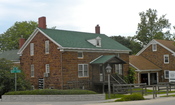By: Mike Kerbe Mike Kerbe U.S. History to 1876 Professor Giaimis October 8, 1999 History of the Amana Communes With the new foundland of north America, Europeans saw a chance to apply their hopes and dreams of a perfect Utopian society. They saw an oppertunity to raise communities of so called 'utopian societies' that they could not create in their already ruled land of Europe. While there would be Utopian experiments is Europe -like the Paris commune and the Fourierist Planxes, it would only be in America where the European divines would apply their Utopian ideals with such effort. The socialism of these early communities was the kind that Marx, rightly or wrongly, would brand as 'utopian,' suggesting that it was idealistic and impractical. Rather than seeking to create an ideal government or reform the world, the members of these communal groups withdrew form the sinful, corrupt world to work their miracles in microcosm, actually hoping to imitate the elect state of affairs that existed among the Apostles, who were said to hold all things in common.
The most interesting point of these communal groups to me might be the overall backing of their desire to create a community. It seems some of the communal groups, such as the Amana, were only created out of feelings of guilt and hope for redemption. From Oveds book, two hundred years of American Communes, he describes the Amana as seeing their community as an island of redemption in a world awash with temptation, sin and avarice; the Elect could come and perfect themselves, if they were prepared to heed the Lord's call to chastity, poverty, simplicity, hard work, purity, and brotherly love. 1 Although they sought redemption, the main driving force behind the Amana was that they sought religious freedom. Unhappy with their religious rights and flixability in Germany, the Amanas left ifn 1842, settling near Buffalo, New York. In 1855, the "community of True Inspiration," as they were called, moved west, forming their first village along the Iowa River. The Amana set up their communities with a diligent effort. Each village practiced their Utopian ideals and worked together as one large community. Perhaps the most impressive view of the Amana may be their unique contributions to social reform. Many aided and abetted the abolitionists, women's rights, and objections to war. Their history and communal methods were basically unchanged for 89 years. The Amana is definitely one of the longest lasting communal societies in the world. In a sense you could actually say it was a bit of a success. The Amana had thier whole social class set up eliminating the need for conflict. The land and buildings were owned by the community; families were assigned living quartyers, and each person over school age worked at assigned tasks in the kitchens, fields, factories ro shops. This proves to me that every member of the commune totally excepted their way of life and basically lived by it. If I was told where to work and what age I had to work, their definetly would have been some rebelling in the community. It seems that all good things come to an end, if you can label that way of life 'good,' because in 1932, the people voted to end the communal way of life. It looks like the Amana way of life may have died, but the Amana people still exist, they created the Amana Church Society to direct matters of their faith, and the Amana Society, Inc. to eversee their businesses and farming operatioins. Today, many of the businesses in the Amana Colonies are independently owned and operated proving to me that they have still retained their individuality from American society as a whole, way to go Amana! 2 Bibliography John Homely, American way. 1996 Word Count: 622





